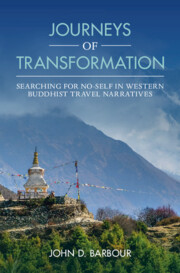Book contents
- Journeys of Transformation
- Reviews
- Journeys of Transformation
- Copyright page
- Dedication
- Contents
- Acknowledgments and Author’s Note
- Introduction A Literary Genre and Some Questions about Self-Transformation
- Chapter 1 The Origins of the Genre
- Chapter 2 Peter Matthiessen’s The Snow Leopard and Nine-Headed Dragon River
- Chapter 3 In a Zen Monastery
- Chapter 4 Thomas Merton and Christian and Jewish Pilgrims in Buddhist Asia
- Chapter 5 Walking the Dharma on Shikoku and in India
- Chapter 6 Trekking and Tracking the Self in Tibet
- Chapter 7 Life-Changing Travels in the Tibetan Diaspora
- Chapter 8 Encounters with Theravada Buddhism
- Chapter 9 Searching for Chan Buddhism after Mao
- Conclusion Theories of No-Self, Stories of Unselfing, and Transformation
- Bibliography
- Index
Chapter 4 - Thomas Merton and Christian and Jewish Pilgrims in Buddhist Asia
Published online by Cambridge University Press: 12 March 2022
- Journeys of Transformation
- Reviews
- Journeys of Transformation
- Copyright page
- Dedication
- Contents
- Acknowledgments and Author’s Note
- Introduction A Literary Genre and Some Questions about Self-Transformation
- Chapter 1 The Origins of the Genre
- Chapter 2 Peter Matthiessen’s The Snow Leopard and Nine-Headed Dragon River
- Chapter 3 In a Zen Monastery
- Chapter 4 Thomas Merton and Christian and Jewish Pilgrims in Buddhist Asia
- Chapter 5 Walking the Dharma on Shikoku and in India
- Chapter 6 Trekking and Tracking the Self in Tibet
- Chapter 7 Life-Changing Travels in the Tibetan Diaspora
- Chapter 8 Encounters with Theravada Buddhism
- Chapter 9 Searching for Chan Buddhism after Mao
- Conclusion Theories of No-Self, Stories of Unselfing, and Transformation
- Bibliography
- Index
Summary
This chapter examines Thomas Merton’s encounters with Buddhism during his 1968 journey in Asia, as recorded in his Asian Journal. He hoped learning from Asian traditions would increase his commitment as a Christian monk. Merton was deeply moved by encounters with Buddhist teachers, including the Dalai Lama, a stark confrontation with the mountain Kanchenjunga in Nepal, and an ecstatic aesthetic experience at the massive sculptures at Polonnaruwa in Sri Lanka. He recorded several moments of unselfing and used the concepts of anicca (impermanence) and anatman (no-self) to understand them. Merton’s example of integrating Buddhist ideas with theistic faith is paralleled by two other Christians and a Jew: William Johnston, Bardwell Smith, and Rodger Kamenetz. Profoundly influenced by Asian journeys, these writers use Buddhist metaphors and stories to explore problems of selfhood. They discern ways in which their own theistic religious tradition is analogous in crucial ways to Buddhist no-self in challenging egotism.
Keywords
- Type
- Chapter
- Information
- Journeys of TransformationSearching for No-Self in Western Buddhist Travel Narratives, pp. 99 - 122Publisher: Cambridge University PressPrint publication year: 2022



